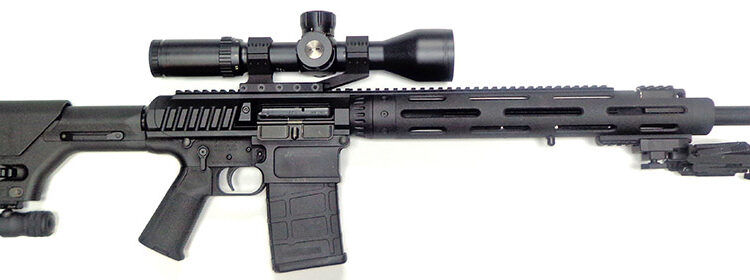By Christopher R. Bartocci
Over the past two decades the AR-10 rifle has come full circle. From being tossed in the scrap heap of the U.S. Ordnance Corps in the late 1950s due to a complete lack of vision to being one of the most popular weapons in the world in 2014. This family of weapons arms the most elite snipers in the world and is used as a basic sniper/designated marksman rifle all over the world. The commercial market is completely flooded with AR-10 variants. There is one company that is well known for accuracy and precision and has totally rethought the design of the rifle and made improvements. Most of those improvements are components designed and manufactured by them. That company is JP Enterprises.
John Paul, a competitive shooter himself, has built his company by one word: precision. Looking at his lineup of components there are many different types of barrels, accessories, fire control group match spring sets, optics mounts and free float rails. Perhaps John Paul is best known for his refinement of the match grade single stage trigger. This author first contacted John Paul while researching enhanced bolt carrier groups for the AR-15/M4 rifles. After talking to John Paul about the reasons for his design, it was time to see one of his complete weapons. The approach John Paul took was an utter balance of the gas system to increase speed and reliability and minimize recoil. In the basic rifle design, the bolt carrier is very heavy to increase reliability with various types of ammunition in various environments under adverse conditions. The heavy mass of the bolt carrier assists in operating the rifle under harsh conditions. However, from a sniper perspective, one would want a smooth recoil rifle with fast follow up shots on target, which is the entire premise of the Semi Automatic Sniper System (SASS). John Paul decreased the weight of the carrier to get a proper balance with the rifle and combined that with another one of his inventions; the Silent Captured Spring. The Silent Captured Spring eliminates the spring sound from the buffer and spring moving during fire by completely eliminating the friction between the spring and the receiver. This also provides an inherent reduction in felt recoil. When the bolt is retracted it is very smooth – almost like on ball bearings.
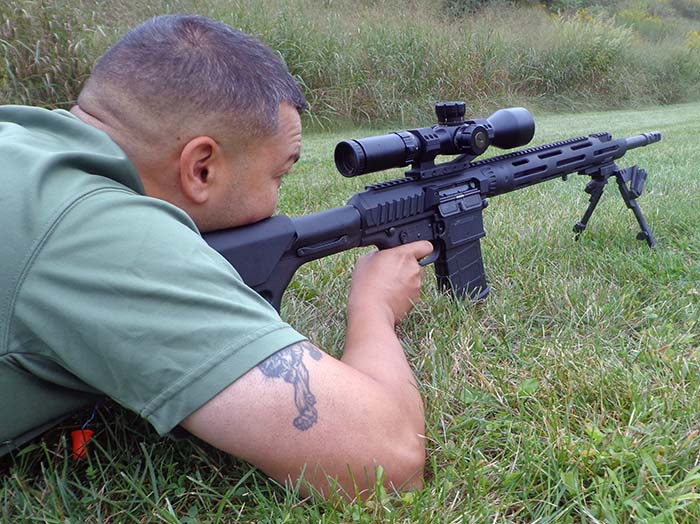
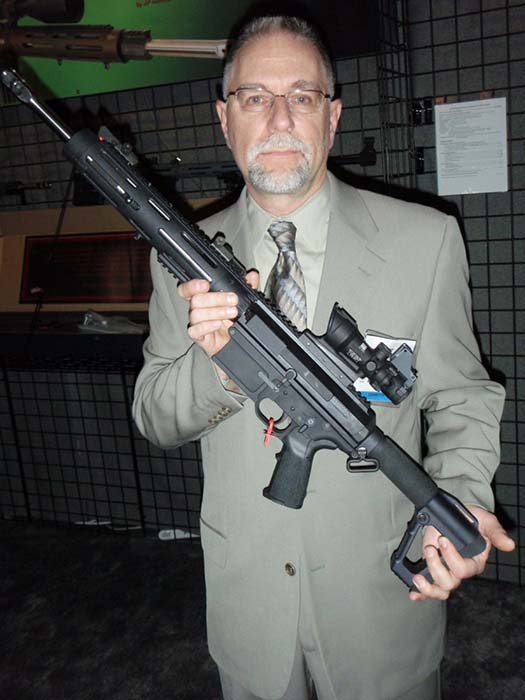
The rifle sent for evaluation is the LRP-07 SASS rifle. According to JP Enterprises, the rifle was designed to cure the shortcomings of existing rifles and still handle like an AR-15. The rifle has many options; the configuration provided was just one of them, however, this is the configuration most popular in military and LE sales. One of the keys to reliability and precision is control of the manufacturing process and tolerances of the major components of the rifle. There are a couple reliable ways of doing this. First and foremost is manufacturing the parts in-house. There is no better way. The parts are manufactured off of a technical data package (TDP) to insure they all function together as intended with a stack of tolerances. The second is to have reliable vendors manufacture the components to the TDP and upon receipt of the parts the company has diligent quality control department inspecting parts to insure they are in specification. JP Enterprises does the most effective measure; they manufacture most of the parts for the rifle in-house.
Starting with the upper receiver, the receiver is machined from billet 7075 T6 aircraft grade aluminum. There is no forward assist on this rifle as it is neither needed nor desirable. However, on the new LRP-07M (M for Military/LE version) it does incorporate a forward assist/fired cartridge case deflector due to the request from the operators. The top of the rail is a Mil-Std 1913 rail. There is a bolted-on fired cartridge case deflector and ejection port cover. One of the more unique aspects of the rifle is on the left side of the upper receiver; the charging handle. John Paul felt that the charging handle would be better suited on the side of the rifle to allow the sniper to manipulate the bolt with his head still on the stock of the rifle. The lever folds out to actuate and is non-reciprocating. It is quite easy to manipulate while maintaining a cheek weld. The fit and finish of the receiver itself is spectacular.
The handguard on the rifle is also of JP Enterprises design. It is common knowledge that free floating a barrel offers the single most enhancement to accuracy of anything you can do to the rifle. The point of aim will not be affected by the use of a bipod nor sling. It is not uncommon to take a rifle shooting 1.5 to 2 MOA, free float the barrel and then achieve sub-MOA level accuracy. The JP Modular Handguard System is precision manufactured from 6061 T6 aluminum with several vent cuts throughout the handguard to not only allow for cooling but for mounting various length Mil-Std 1913 rail segments. Unlike most other rails of this sort, no special wrench or strap wrench is used for assembly. Only the standard AR-15/M16 barrel wrench is used. The 2-inch tube is more comfortable than standard free float handguards that are normally 3.35-inches in diameter. The JP Modular Hand Guard System comes in many different lengths including carbine, mid-length, standard rifle and larger .308 rifle lengths.
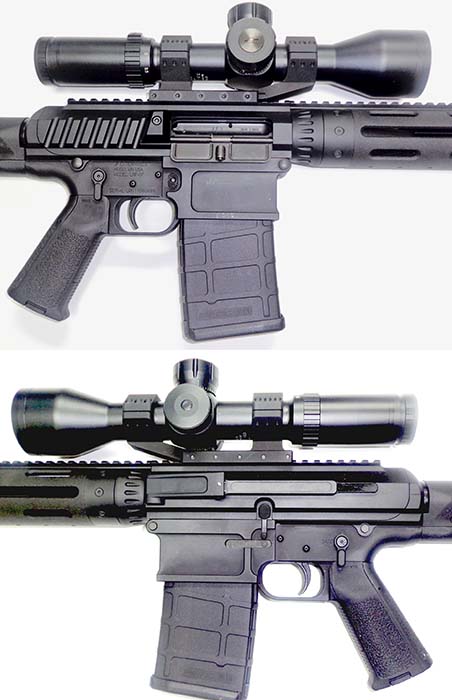
The barrel is a JP Supermatch barrel manufactured from 416-R stainless steel and rifled with a 1 turn in 10 inches and 6 lands and grooves and a right hand twist. After the center bore is drilled the barrel is lead-lapped. Then the rifle barrel is button-rifled for precision. The barrel is air-gauged to ensure minimal bore diameter run out for peak accuracy. After completed, the barrel is cryogenically treated for cold bore shot predictability, minimum thermal drift, outstanding accuracy and extended barrel life. The barrel finish is polished stainless steel. The end of the barrel is equipped with a Surefire MB762-211C muzzle brake/QD sound suppressor mount.
After the barrel was assembled on the receiver, JP Enterprises added another of their innovative products; the Thermal Dissipater. This attaches to any of the new JP medium contoured barrels between the gas block and the front of the upper receiver, which results in an increase of surface area of 700% under the handguard. According to JP Enterprises, tests show that the most heat created by sustained fire is 2 to 3 inches in front of the chamber causing throat erosion and reduced accuracy over time. The JP Thermal Dissipater far exceeds traditional fluting for transferring heat from the barrel. The dissipater is an anodized, deep finned 6061 T6 extruded 2-piece sleeve and attaches to any .650 or .750 outside diameter barrel. The Dissipater not only improves cooling but maintains a more uniform barrel temperature.

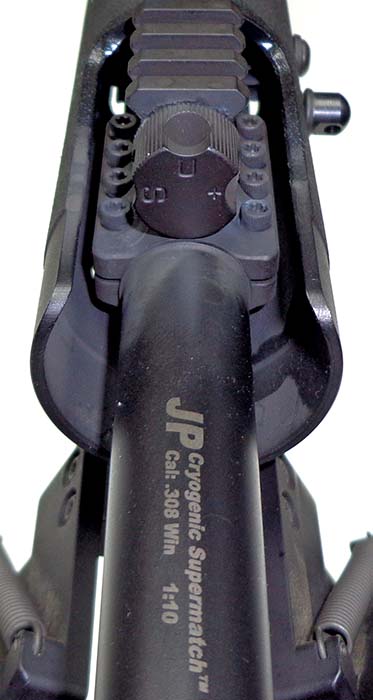
The gas block is also manufactured by JP Enterprises. The one provided on the test rifle has a Mil-Std 1913 rail on top and is adjustable. There are three settings: one for suppressed, normal and a +- position for adverse conditions. The regulator can be turned either by hand or with the assistance of a bullet tip. To hold the gas block in place, a two piece clamp system using 8 socket head cap screws with a lug incorporated into the top section to prevent thermal migration due to any differential in expansion rates between the barrel and the gas manifold causing it to loosen up under extreme thermal load. At this point, most shooters know that “set screw” retained gas blocks are not reliable under high thermal load. So that term has a very negative connotation. A bit of history – when these civilian type AR rifles started to come on the scene, almost everyone used one piece gas blocks that used set screws for retention, including JP Enterprises. JP Enterprises noticed this thermal load problem with high volume shooters and decided to come up with several fixes, depending on the gas block JP Enterprises uses. Obviously, if lives depended on the rifle, this was not acceptable.
The lower receiver is also manufactured from a 7075 T6 billet. The stock is the high quality Magpul PRS Stock. This stock has an adjustable cheek weld as well as butt to customize for the user. The Magpul MIAD pistol grip is used that also provides the shooter several options. There are three different back straps to customize based on the size of the shooters hand. The front strap is removable as well with inserts with and without finger grooves. The selector lever is also a JP Enterprises design. The safety is ambidextrous, the lever on the right side is low profile and the selector can be used to eliminate the safety fitting process. The trigger mechanism is the standard drop in match JP Enterprises match single stage trigger group. The low-mass hammer speeds up firing by striking the firing pin faster, which increases accuracy. The trigger is adjustable with screws to control creep. There are two different hammer springs. The yellow hammer spring is intended for competition and recreational applications. It will be used with handloads and nonmilitary ammunition. When combined with the yellow hammer and trigger spring the trigger pull is 3 to 3.5 pounds. The red spring MUST be used in any tactical or duty rifle. The increased power spring is necessary to fire harder military primers for 100% ignition. The yellow trigger/red hammer spring combination gives a 3.5 to 4 pound trigger pull. The test and evaluation rifle was equipped with this yellow trigger/red hammer spring combination and the trigger broke at 4.75 pounds; breaking cleanly with no creep at all. The fire control group was held in place by JP Enterprises Oversized Anti-Walk hammer/trigger pins. The black oxide finished pins have four button head screws which prevent the pins from walking out of the receiver.
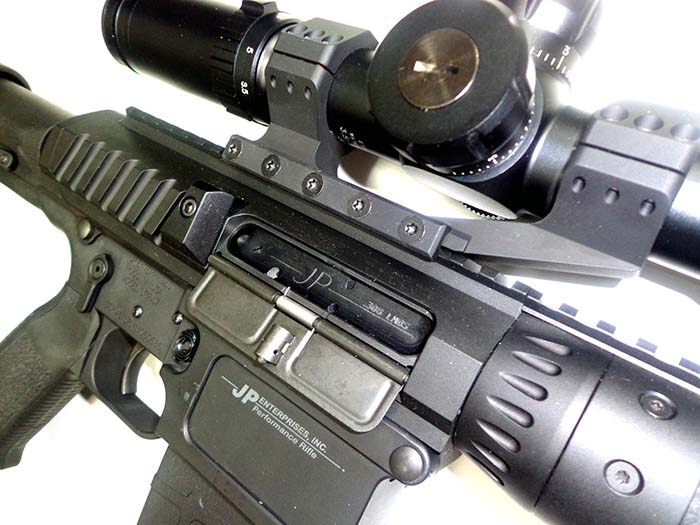
One of the most unique features on this rifle is that it does not use the conventional AR-type buffer. John Paul was never fond of the noise made by the friction of the recoil spring on the inside of the receiver extension. He felt it was annoying and distracting so he developed the Silent Captured Spring (patent pending). In appearance it looks like an oversized pistol spring guide. The rear of the unit has a large neoprene-type bumper and the front has two circular shaped weights. The spring at no point comes in contact with the receiver extension. The lower receiver does not have a buffer retainer pin or spring. This Silent Captured Spring unit just drops into the receiver extension. The unit is set up to drop in a telescopic stock receiver extension, when installing in a rifle length receiver extension a spacer is provided, which drops into the receiver extension first then followed by the Silent Captured Spring assembly. There may be some compatibility issues with nonstandard receiver extensions. Consult JP Enterprises for technical info on compatibility.
The bolt carrier group is also another proprietary engineered JP Enterprises enhancement called the JP .308 Low Mass Operating System (LMOS). According to JP Enterprises, the LMOS offers the most significant improvement in the felt impulse of the rifle as compared to any modification other than the addition of a compensator. The LMOS consists of the JP Enterprises low mass bolt carrier and light weight buffer conversion unit. The theory is by reducing the reciprocating mass; the overall impulse felt by the shooter is further reduced. And the bolt velocity is increased without affecting reliability. Accordingly, their JP LMOS equipped rifles have virtually no reciprocating mass feel. Many users of this system claim they experience fewer “flyers” and they feel the LMOS is a great performance improvement. The finish on the bolt carrier appears black and it is a stainless steel carrier. The color comes from a new state-of-the-art finishing process called QPQ or Quench, Polish, Quench. This is a five step process resulting in a rock hard surface with natural lubricity. Before attempting to insert or fire a JP bolt carrier group with another manufacturers bolt, contact technical services at JP Enterprises to determine compatibility.

The bolt itself is of JP Enterprises design and is considered by them to be an enhanced bolt. The much stronger SAE 9310 high-grade steel is used. This material makes for an extremely hard surface with a tough, ductile core resistant to structural failure and life expectancy far exceeding Mil-Spec C-158 bolts. The SAE 9310 is the same type of material used in the transmission gears of Formula One race cars. The durability of these bolts during large volumes of fully automatic fire prove the superiority of the SAE 9310 over the Mil-Spec C-158 bolts.
The rifle was sent with three Magpul PMag 20LR magazines. The rifle was also tested with the Knight’s Armament Company steel magazine as well as the C-Products steel magazine. The rifle was also supplied with a Bobro Engineering Type 3-Blac bipod. The patented CTM (Collapsing Triangle Mechanism) technology permits deployment without the control manipulation such as buttons. The bipod is deployed by pulling the legs rearward fully until the claw within the clawbox applies pressure to the clawbox post. A conical interface applies constant and even pressure to ensure the bipod remains positively locked in the deployed position. To collapse the bipod, depress the claw pivot and start pushing the legs forward. All the aluminum components are manufactured from 6061 T6 aluminum and hard anodized as per military specifications. All fasteners are phosphate coated Mil-Spec or oxide treated 304 stainless steel.
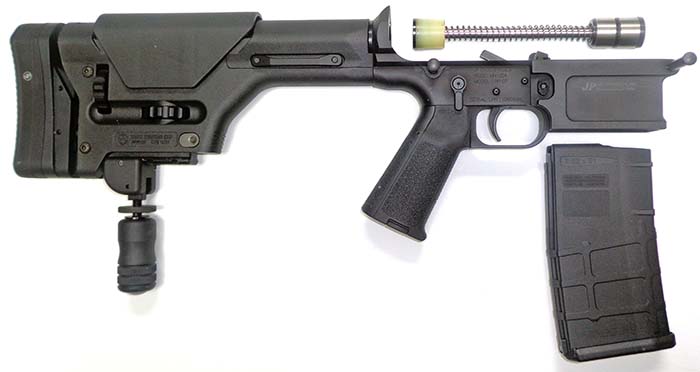
The optic was mounted to a JP Enterprises JPFTSM-35 flat top scope mount. The mount is installed to a Mil-Std 1913 rail and held in place by four screws. The intermediate height mount accommodates from 35 to 56 mm objectives and will fit any 35 mm tube. It features an integrated recoil lug, high centerline (1.5” over rail) and manufactured from 6061 T6 aluminum.
The optic provided on the rifle was the Bushnell Elite Tactical DMR 3.5-21x50mm rifle scope. The low 3.5 power setting allows for an up close CQB type optic and then adjusts to long range precision. The scope has a flat black finish and weighs 32.5 oz. The lens is covered with a RainGuard HD, fully multi-coated finish. It repels moisture, including snow, rain, condensation, and breath from obstructing the lens. There is a 3-inch sunshade that blocks glare from the viewfinder. The tactical turret allows rapid windage and elevation adjustments. Pull outward on the knob to unlock and make adjustments. Then when completed push the knob in and lock it in place. The reticle on the scope is the G2 DMR. Increments are in this reticle to accommodate distance as well as lead.
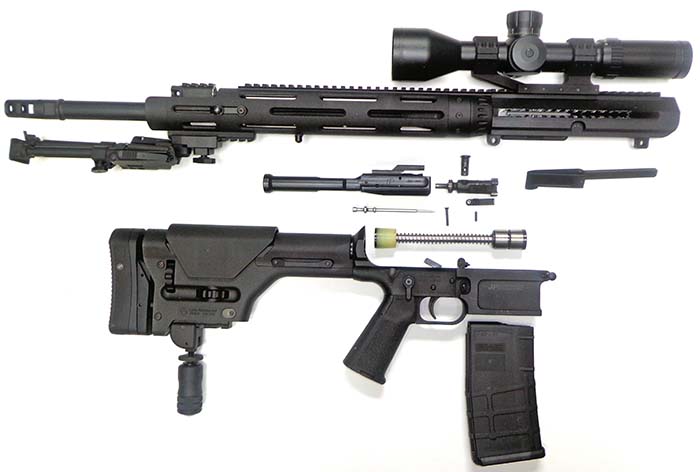
The rifle was test fired with Black Hills .308 Win. 168 and 175 grain MatchKing projectiles, Federal Gold Medal 175 grain open tip Match and Hornady Superformance Match 178gr BTHP. The range was 100 yards. Rochester Police Department Emergency Task Force Sniper Police Officer Fabian Rivera was on hand to test the rifle. The rifle functioned flawlessly with all ammunition it was given. The best group of the day was shot with the Federal Gold Medal ammunition with .410 inches 5-shot group. For the most part all the ammunition shot sub-MOA. PO Rivera is use to AR-10-type platform rifle though his agency is switching over to SASS rifles. He felt this was the smoothest firing rifle of its sort. He was quite impressed by the accuracy and the lack of recoil compared to what he was used to.
There are many AR-10 type rifles out there; the JP Enterprises LRP-07 SASS is one of the most elite. This precision rifle is comprised of components mostly designed and manufactured by them, which is a contributing factor to the reliability and precision accuracy of this rifle. This is a specialized tool for military and law enforcement snipers.
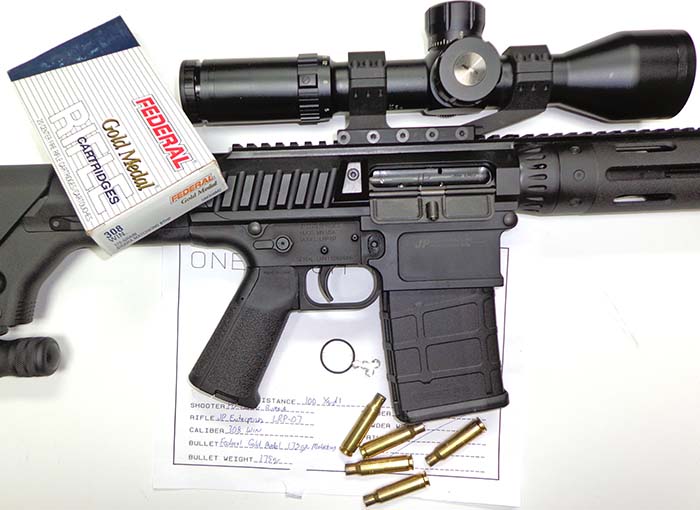
| This article first appeared in Small Arms Review V18N4 (August 2014) |



